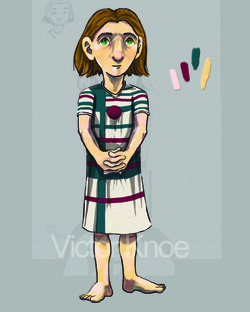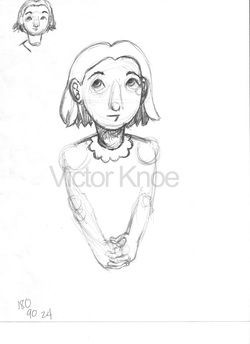
Character designed digitally
Recently, I've been thinking a lot about the differences between working digitally and working with traditional materials. The difference that plagues me the most is the length of time it takes for me to work digitally as opposed to traditionally.
Working on this character, for example, took me about four to five hours to develop to this point. Now, my digital skills have become rusty from not using my programs. I understand that things can get faster with time, but I think my problem has to do with something a little deeper than just getting used to a few buttons here and there. . .
Working on this character, for example, took me about four to five hours to develop to this point. Now, my digital skills have become rusty from not using my programs. I understand that things can get faster with time, but I think my problem has to do with something a little deeper than just getting used to a few buttons here and there. . .

Character drawn in pen
Consider this drawing I made with a ball-point pen. It took me no more than 10 minutes to complete this drawing. Granted, it's just a quick sketch, but this is one characteristic that I love about traditional media: limtations.
As you may know, working in pen is unforgiving. You simply have to deal with any mistakes you make. That's part of what makes an artist in the traditional sense.
Working digitally, however, can be too forgiving. For someone like me, I can spend hours working and re-working a particular area on an illustration and, before I realize it, I've spent an entire day working without much output. Sometimes a project will warrant that kind of time being spent. My problem is that every digital project becomes a time vacuum.
So, before it starts to sound like I'm knocking one and preferring the other, let me clarify: I love both processes. My point is that they are two totally different animals and, like animals, you've got to know how to master them respectively.
Here's a small pros and cons list of both processes, just to get the old hamster wheel rolling:
As you may know, working in pen is unforgiving. You simply have to deal with any mistakes you make. That's part of what makes an artist in the traditional sense.
Working digitally, however, can be too forgiving. For someone like me, I can spend hours working and re-working a particular area on an illustration and, before I realize it, I've spent an entire day working without much output. Sometimes a project will warrant that kind of time being spent. My problem is that every digital project becomes a time vacuum.
So, before it starts to sound like I'm knocking one and preferring the other, let me clarify: I love both processes. My point is that they are two totally different animals and, like animals, you've got to know how to master them respectively.
Here's a small pros and cons list of both processes, just to get the old hamster wheel rolling:
Digital Media
What I like:* Highly forgiving (unless you forget to "Save") * Less messy * Less time spent on priming/preparing * Greater possibility for precision and accuracy of artistic intention * One work can be used multiple times in various ways | What I dislike:* Less personal/human element in final product * Limits intuition * Synthetic * Long periods looking at screen may be harmful to eyes * Lesser variety of marks * Greater knowledge of computers and software is favorable |
Traditional Media
What I like:* Immediate, tangible product * Greater possibility of marks * Sharpens skills * Does not rely on electricity * Deepens intuition | What I dislike:* Can be very messy * Unforgiving * Greater knowledge of materials is favorable * More time spent gathering materials and preparing * Final product is more limited |
-Victor


 RSS Feed
RSS Feed